DET Unit 502: A Comprehensive Report on Education and Training
VerifiedAdded on 2023/06/18
|17
|6844
|63
Report
AI Summary
This report provides a comprehensive analysis of theories, principles, and models in education and training, focusing on their application in a college setting. It covers behavioral, cognitive, and humanist learning theories, along with principles like participation, repetition, and feedback. The report explores various learning preference models such as Kolb and Honey Mumford, emphasizing the importance of individual learner preferences for inclusive teaching and assessment. It also examines communication theories like cognitive dissonance and accommodation, alongside principles of clarity, attention, and feedback. Furthermore, the report delves into assessment theories and models, curriculum development, and reflection and evaluation methodologies, providing a holistic view of effective educational practices. Desklib offers a platform for students to access this report and other solved assignments for further study.
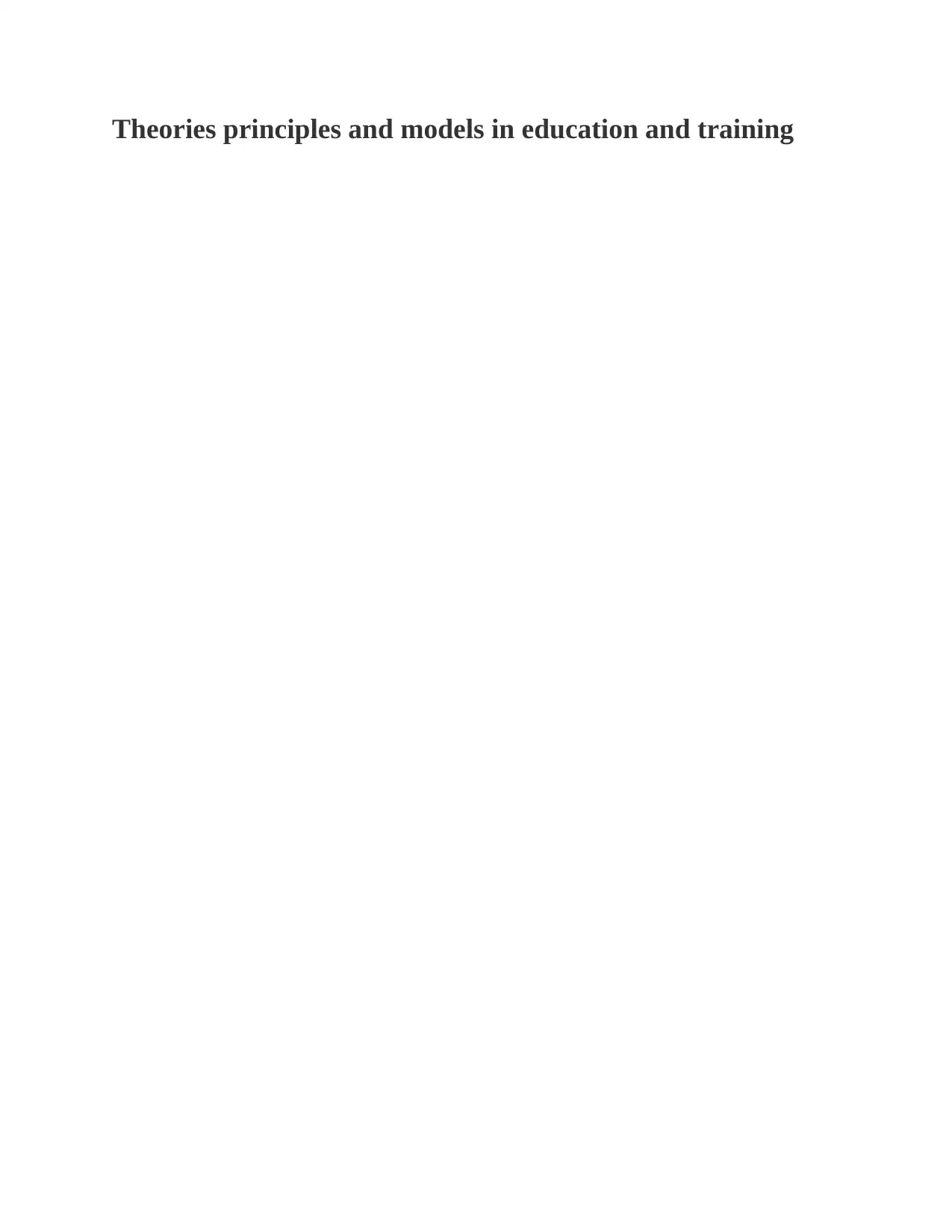
Theories principles and models in education and training
Paraphrase This Document
Need a fresh take? Get an instant paraphrase of this document with our AI Paraphraser
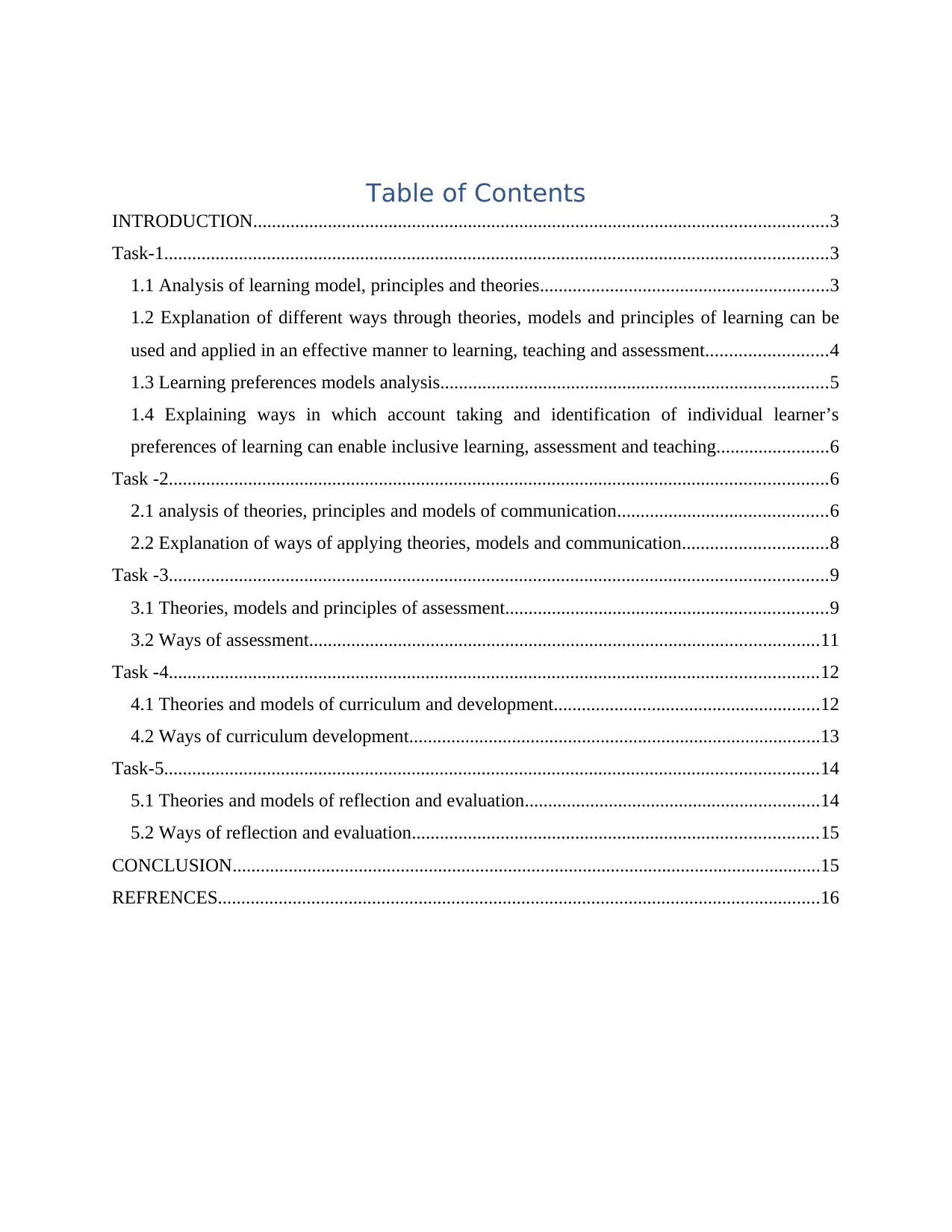
Table of Contents
INTRODUCTION...........................................................................................................................3
Task-1..............................................................................................................................................3
1.1 Analysis of learning model, principles and theories..............................................................3
1.2 Explanation of different ways through theories, models and principles of learning can be
used and applied in an effective manner to learning, teaching and assessment..........................4
1.3 Learning preferences models analysis...................................................................................5
1.4 Explaining ways in which account taking and identification of individual learner’s
preferences of learning can enable inclusive learning, assessment and teaching........................6
Task -2.............................................................................................................................................6
2.1 analysis of theories, principles and models of communication.............................................6
2.2 Explanation of ways of applying theories, models and communication...............................8
Task -3.............................................................................................................................................9
3.1 Theories, models and principles of assessment.....................................................................9
3.2 Ways of assessment.............................................................................................................11
Task -4...........................................................................................................................................12
4.1 Theories and models of curriculum and development.........................................................12
4.2 Ways of curriculum development........................................................................................13
Task-5............................................................................................................................................14
5.1 Theories and models of reflection and evaluation...............................................................14
5.2 Ways of reflection and evaluation.......................................................................................15
CONCLUSION..............................................................................................................................15
REFRENCES.................................................................................................................................16
INTRODUCTION...........................................................................................................................3
Task-1..............................................................................................................................................3
1.1 Analysis of learning model, principles and theories..............................................................3
1.2 Explanation of different ways through theories, models and principles of learning can be
used and applied in an effective manner to learning, teaching and assessment..........................4
1.3 Learning preferences models analysis...................................................................................5
1.4 Explaining ways in which account taking and identification of individual learner’s
preferences of learning can enable inclusive learning, assessment and teaching........................6
Task -2.............................................................................................................................................6
2.1 analysis of theories, principles and models of communication.............................................6
2.2 Explanation of ways of applying theories, models and communication...............................8
Task -3.............................................................................................................................................9
3.1 Theories, models and principles of assessment.....................................................................9
3.2 Ways of assessment.............................................................................................................11
Task -4...........................................................................................................................................12
4.1 Theories and models of curriculum and development.........................................................12
4.2 Ways of curriculum development........................................................................................13
Task-5............................................................................................................................................14
5.1 Theories and models of reflection and evaluation...............................................................14
5.2 Ways of reflection and evaluation.......................................................................................15
CONCLUSION..............................................................................................................................15
REFRENCES.................................................................................................................................16
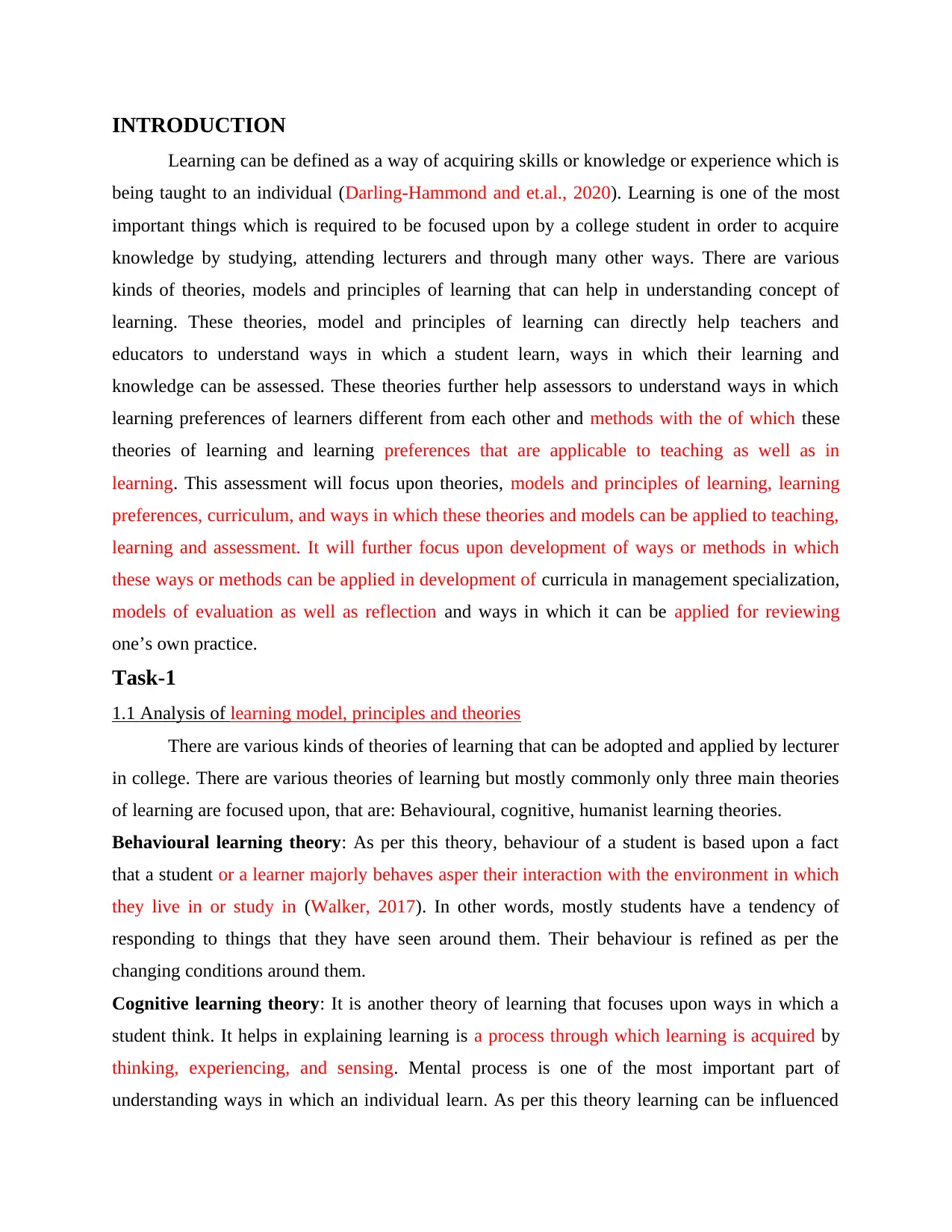
INTRODUCTION
Learning can be defined as a way of acquiring skills or knowledge or experience which is
being taught to an individual (Darling-Hammond and et.al., 2020). Learning is one of the most
important things which is required to be focused upon by a college student in order to acquire
knowledge by studying, attending lecturers and through many other ways. There are various
kinds of theories, models and principles of learning that can help in understanding concept of
learning. These theories, model and principles of learning can directly help teachers and
educators to understand ways in which a student learn, ways in which their learning and
knowledge can be assessed. These theories further help assessors to understand ways in which
learning preferences of learners different from each other and methods with the of which these
theories of learning and learning preferences that are applicable to teaching as well as in
learning. This assessment will focus upon theories, models and principles of learning, learning
preferences, curriculum, and ways in which these theories and models can be applied to teaching,
learning and assessment. It will further focus upon development of ways or methods in which
these ways or methods can be applied in development of curricula in management specialization,
models of evaluation as well as reflection and ways in which it can be applied for reviewing
one’s own practice.
Task-1
1.1 Analysis of learning model, principles and theories
There are various kinds of theories of learning that can be adopted and applied by lecturer
in college. There are various theories of learning but mostly commonly only three main theories
of learning are focused upon, that are: Behavioural, cognitive, humanist learning theories.
Behavioural learning theory: As per this theory, behaviour of a student is based upon a fact
that a student or a learner majorly behaves asper their interaction with the environment in which
they live in or study in (Walker, 2017). In other words, mostly students have a tendency of
responding to things that they have seen around them. Their behaviour is refined as per the
changing conditions around them.
Cognitive learning theory: It is another theory of learning that focuses upon ways in which a
student think. It helps in explaining learning is a process through which learning is acquired by
thinking, experiencing, and sensing. Mental process is one of the most important part of
understanding ways in which an individual learn. As per this theory learning can be influenced
Learning can be defined as a way of acquiring skills or knowledge or experience which is
being taught to an individual (Darling-Hammond and et.al., 2020). Learning is one of the most
important things which is required to be focused upon by a college student in order to acquire
knowledge by studying, attending lecturers and through many other ways. There are various
kinds of theories, models and principles of learning that can help in understanding concept of
learning. These theories, model and principles of learning can directly help teachers and
educators to understand ways in which a student learn, ways in which their learning and
knowledge can be assessed. These theories further help assessors to understand ways in which
learning preferences of learners different from each other and methods with the of which these
theories of learning and learning preferences that are applicable to teaching as well as in
learning. This assessment will focus upon theories, models and principles of learning, learning
preferences, curriculum, and ways in which these theories and models can be applied to teaching,
learning and assessment. It will further focus upon development of ways or methods in which
these ways or methods can be applied in development of curricula in management specialization,
models of evaluation as well as reflection and ways in which it can be applied for reviewing
one’s own practice.
Task-1
1.1 Analysis of learning model, principles and theories
There are various kinds of theories of learning that can be adopted and applied by lecturer
in college. There are various theories of learning but mostly commonly only three main theories
of learning are focused upon, that are: Behavioural, cognitive, humanist learning theories.
Behavioural learning theory: As per this theory, behaviour of a student is based upon a fact
that a student or a learner majorly behaves asper their interaction with the environment in which
they live in or study in (Walker, 2017). In other words, mostly students have a tendency of
responding to things that they have seen around them. Their behaviour is refined as per the
changing conditions around them.
Cognitive learning theory: It is another theory of learning that focuses upon ways in which a
student think. It helps in explaining learning is a process through which learning is acquired by
thinking, experiencing, and sensing. Mental process is one of the most important part of
understanding ways in which an individual learn. As per this theory learning can be influenced
⊘ This is a preview!⊘
Do you want full access?
Subscribe today to unlock all pages.

Trusted by 1+ million students worldwide
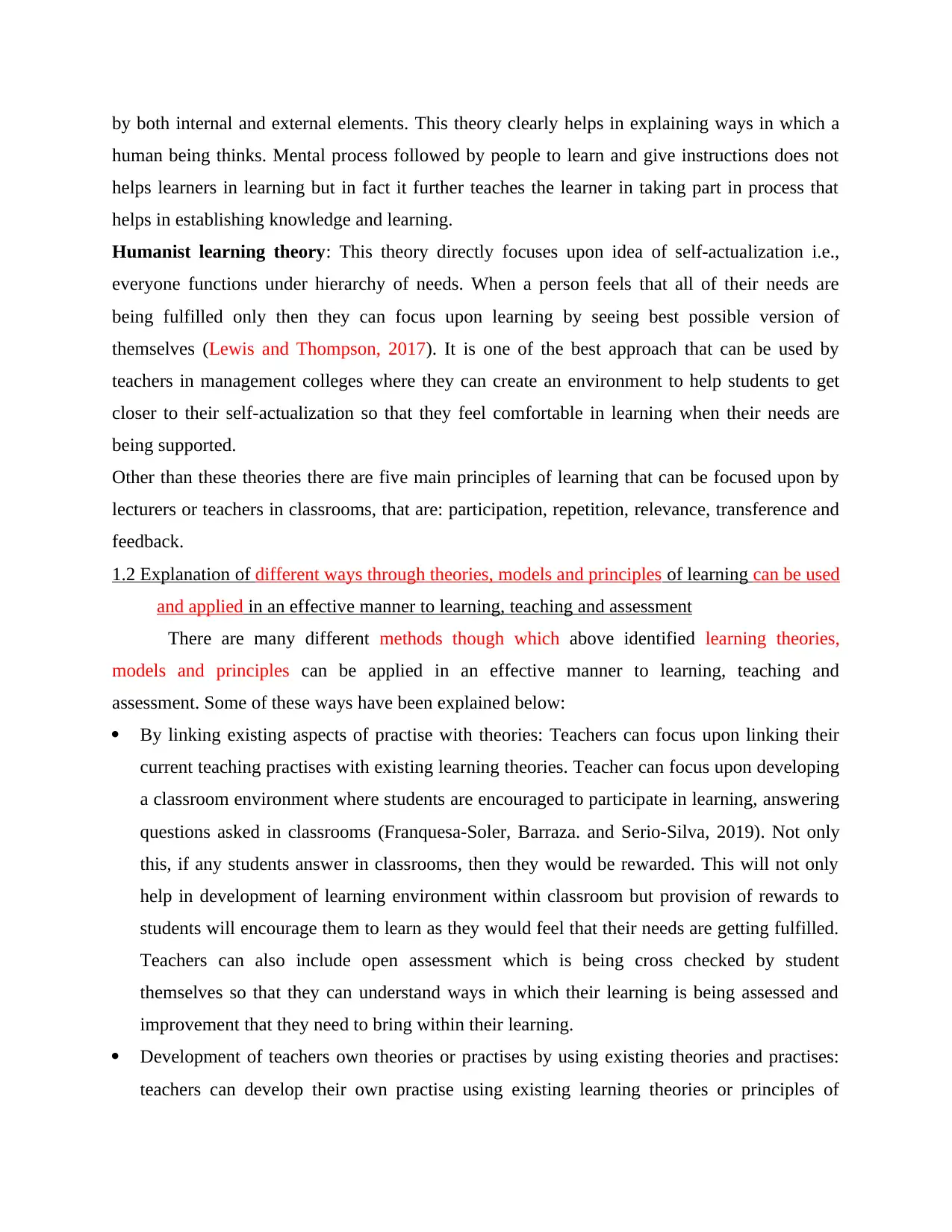
by both internal and external elements. This theory clearly helps in explaining ways in which a
human being thinks. Mental process followed by people to learn and give instructions does not
helps learners in learning but in fact it further teaches the learner in taking part in process that
helps in establishing knowledge and learning.
Humanist learning theory: This theory directly focuses upon idea of self-actualization i.e.,
everyone functions under hierarchy of needs. When a person feels that all of their needs are
being fulfilled only then they can focus upon learning by seeing best possible version of
themselves (Lewis and Thompson, 2017). It is one of the best approach that can be used by
teachers in management colleges where they can create an environment to help students to get
closer to their self-actualization so that they feel comfortable in learning when their needs are
being supported.
Other than these theories there are five main principles of learning that can be focused upon by
lecturers or teachers in classrooms, that are: participation, repetition, relevance, transference and
feedback.
1.2 Explanation of different ways through theories, models and principles of learning can be used
and applied in an effective manner to learning, teaching and assessment
There are many different methods though which above identified learning theories,
models and principles can be applied in an effective manner to learning, teaching and
assessment. Some of these ways have been explained below:
By linking existing aspects of practise with theories: Teachers can focus upon linking their
current teaching practises with existing learning theories. Teacher can focus upon developing
a classroom environment where students are encouraged to participate in learning, answering
questions asked in classrooms (Franquesa-Soler, Barraza. and Serio-Silva, 2019). Not only
this, if any students answer in classrooms, then they would be rewarded. This will not only
help in development of learning environment within classroom but provision of rewards to
students will encourage them to learn as they would feel that their needs are getting fulfilled.
Teachers can also include open assessment which is being cross checked by student
themselves so that they can understand ways in which their learning is being assessed and
improvement that they need to bring within their learning.
Development of teachers own theories or practises by using existing theories and practises:
teachers can develop their own practise using existing learning theories or principles of
human being thinks. Mental process followed by people to learn and give instructions does not
helps learners in learning but in fact it further teaches the learner in taking part in process that
helps in establishing knowledge and learning.
Humanist learning theory: This theory directly focuses upon idea of self-actualization i.e.,
everyone functions under hierarchy of needs. When a person feels that all of their needs are
being fulfilled only then they can focus upon learning by seeing best possible version of
themselves (Lewis and Thompson, 2017). It is one of the best approach that can be used by
teachers in management colleges where they can create an environment to help students to get
closer to their self-actualization so that they feel comfortable in learning when their needs are
being supported.
Other than these theories there are five main principles of learning that can be focused upon by
lecturers or teachers in classrooms, that are: participation, repetition, relevance, transference and
feedback.
1.2 Explanation of different ways through theories, models and principles of learning can be used
and applied in an effective manner to learning, teaching and assessment
There are many different methods though which above identified learning theories,
models and principles can be applied in an effective manner to learning, teaching and
assessment. Some of these ways have been explained below:
By linking existing aspects of practise with theories: Teachers can focus upon linking their
current teaching practises with existing learning theories. Teacher can focus upon developing
a classroom environment where students are encouraged to participate in learning, answering
questions asked in classrooms (Franquesa-Soler, Barraza. and Serio-Silva, 2019). Not only
this, if any students answer in classrooms, then they would be rewarded. This will not only
help in development of learning environment within classroom but provision of rewards to
students will encourage them to learn as they would feel that their needs are getting fulfilled.
Teachers can also include open assessment which is being cross checked by student
themselves so that they can understand ways in which their learning is being assessed and
improvement that they need to bring within their learning.
Development of teachers own theories or practises by using existing theories and practises:
teachers can develop their own practise using existing learning theories or principles of
Paraphrase This Document
Need a fresh take? Get an instant paraphrase of this document with our AI Paraphraser
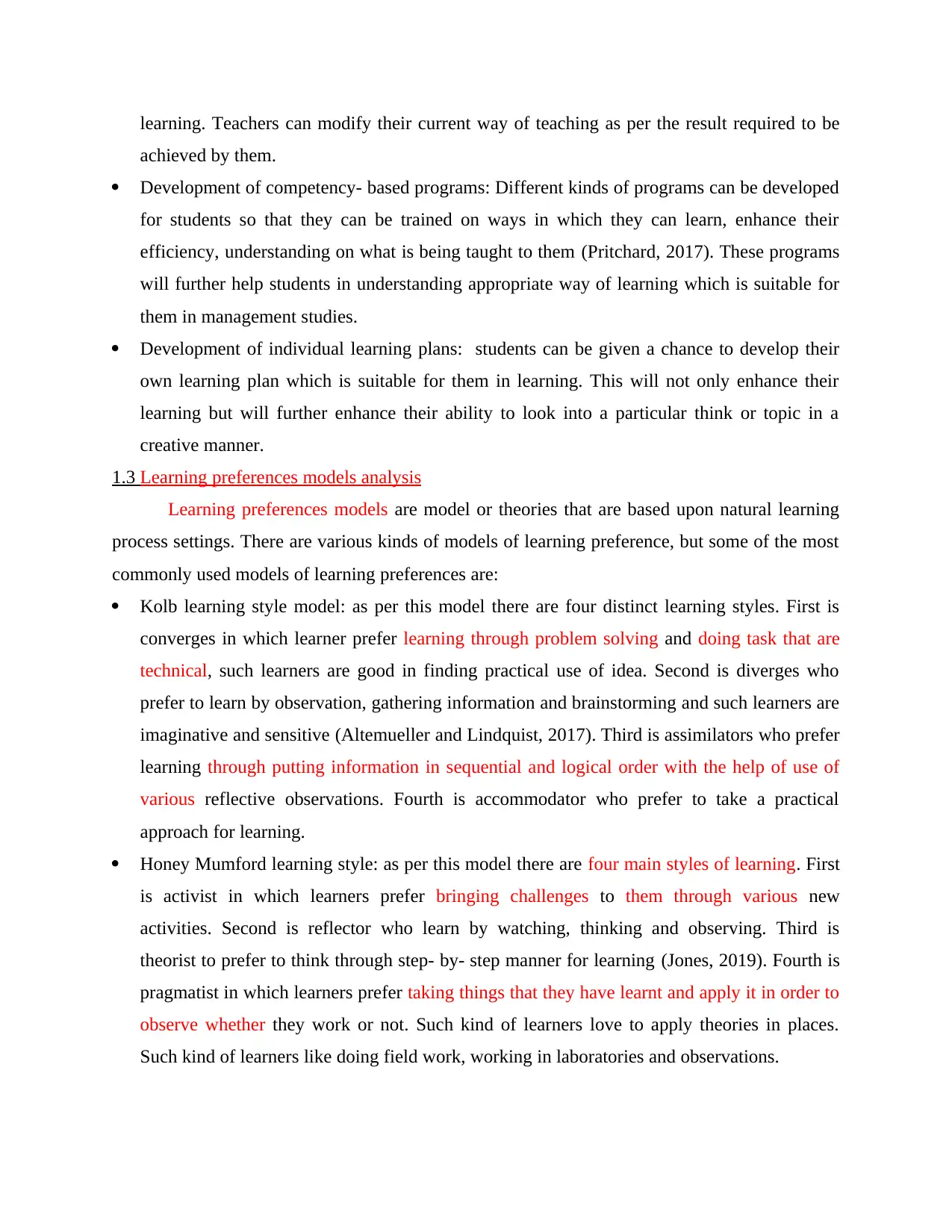
learning. Teachers can modify their current way of teaching as per the result required to be
achieved by them.
Development of competency- based programs: Different kinds of programs can be developed
for students so that they can be trained on ways in which they can learn, enhance their
efficiency, understanding on what is being taught to them (Pritchard, 2017). These programs
will further help students in understanding appropriate way of learning which is suitable for
them in management studies.
Development of individual learning plans: students can be given a chance to develop their
own learning plan which is suitable for them in learning. This will not only enhance their
learning but will further enhance their ability to look into a particular think or topic in a
creative manner.
1.3 Learning preferences models analysis
Learning preferences models are model or theories that are based upon natural learning
process settings. There are various kinds of models of learning preference, but some of the most
commonly used models of learning preferences are:
Kolb learning style model: as per this model there are four distinct learning styles. First is
converges in which learner prefer learning through problem solving and doing task that are
technical, such learners are good in finding practical use of idea. Second is diverges who
prefer to learn by observation, gathering information and brainstorming and such learners are
imaginative and sensitive (Altemueller and Lindquist, 2017). Third is assimilators who prefer
learning through putting information in sequential and logical order with the help of use of
various reflective observations. Fourth is accommodator who prefer to take a practical
approach for learning.
Honey Mumford learning style: as per this model there are four main styles of learning. First
is activist in which learners prefer bringing challenges to them through various new
activities. Second is reflector who learn by watching, thinking and observing. Third is
theorist to prefer to think through step- by- step manner for learning (Jones, 2019). Fourth is
pragmatist in which learners prefer taking things that they have learnt and apply it in order to
observe whether they work or not. Such kind of learners love to apply theories in places.
Such kind of learners like doing field work, working in laboratories and observations.
achieved by them.
Development of competency- based programs: Different kinds of programs can be developed
for students so that they can be trained on ways in which they can learn, enhance their
efficiency, understanding on what is being taught to them (Pritchard, 2017). These programs
will further help students in understanding appropriate way of learning which is suitable for
them in management studies.
Development of individual learning plans: students can be given a chance to develop their
own learning plan which is suitable for them in learning. This will not only enhance their
learning but will further enhance their ability to look into a particular think or topic in a
creative manner.
1.3 Learning preferences models analysis
Learning preferences models are model or theories that are based upon natural learning
process settings. There are various kinds of models of learning preference, but some of the most
commonly used models of learning preferences are:
Kolb learning style model: as per this model there are four distinct learning styles. First is
converges in which learner prefer learning through problem solving and doing task that are
technical, such learners are good in finding practical use of idea. Second is diverges who
prefer to learn by observation, gathering information and brainstorming and such learners are
imaginative and sensitive (Altemueller and Lindquist, 2017). Third is assimilators who prefer
learning through putting information in sequential and logical order with the help of use of
various reflective observations. Fourth is accommodator who prefer to take a practical
approach for learning.
Honey Mumford learning style: as per this model there are four main styles of learning. First
is activist in which learners prefer bringing challenges to them through various new
activities. Second is reflector who learn by watching, thinking and observing. Third is
theorist to prefer to think through step- by- step manner for learning (Jones, 2019). Fourth is
pragmatist in which learners prefer taking things that they have learnt and apply it in order to
observe whether they work or not. Such kind of learners love to apply theories in places.
Such kind of learners like doing field work, working in laboratories and observations.
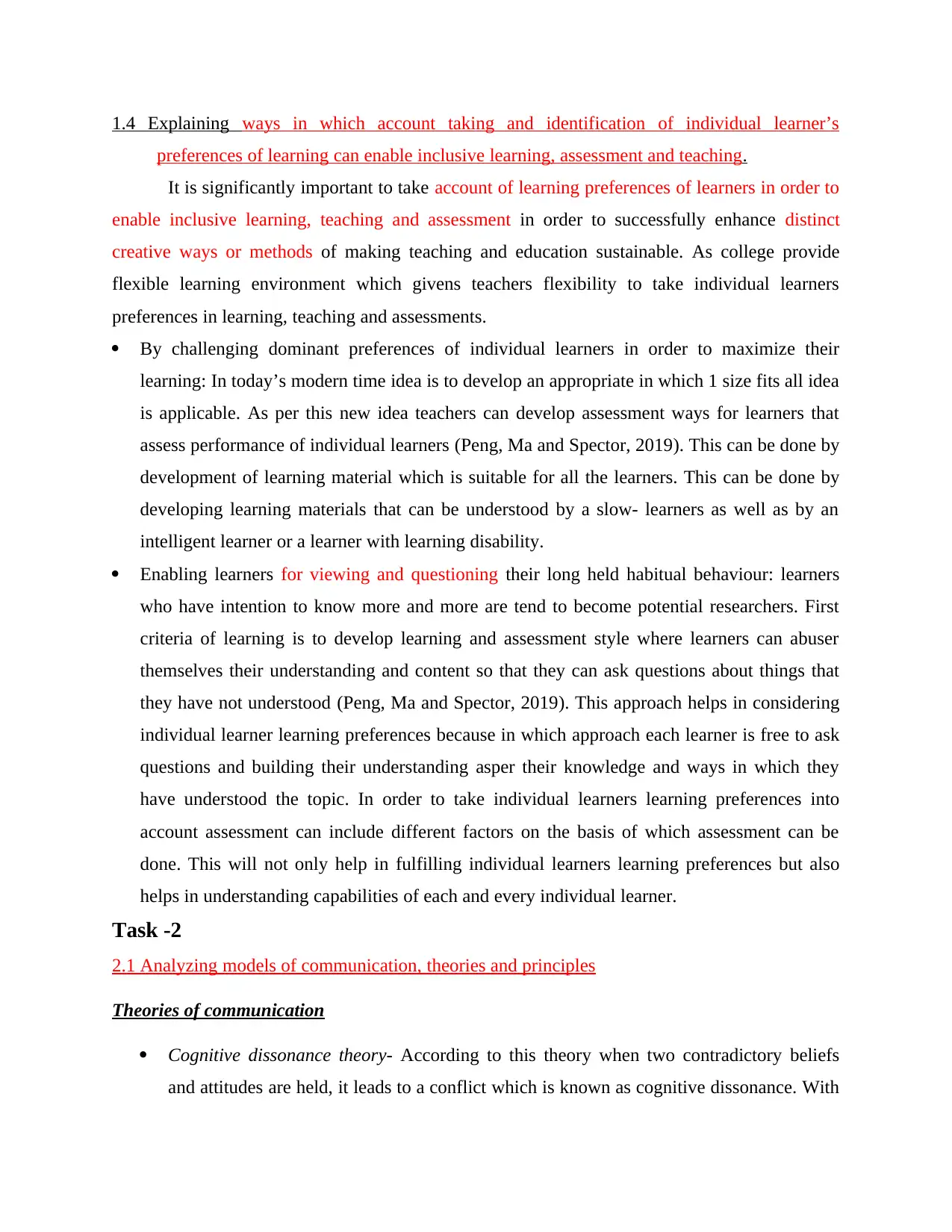
1.4 Explaining ways in which account taking and identification of individual learner’s
preferences of learning can enable inclusive learning, assessment and teaching.
It is significantly important to take account of learning preferences of learners in order to
enable inclusive learning, teaching and assessment in order to successfully enhance distinct
creative ways or methods of making teaching and education sustainable. As college provide
flexible learning environment which givens teachers flexibility to take individual learners
preferences in learning, teaching and assessments.
By challenging dominant preferences of individual learners in order to maximize their
learning: In today’s modern time idea is to develop an appropriate in which 1 size fits all idea
is applicable. As per this new idea teachers can develop assessment ways for learners that
assess performance of individual learners (Peng, Ma and Spector, 2019). This can be done by
development of learning material which is suitable for all the learners. This can be done by
developing learning materials that can be understood by a slow- learners as well as by an
intelligent learner or a learner with learning disability.
Enabling learners for viewing and questioning their long held habitual behaviour: learners
who have intention to know more and more are tend to become potential researchers. First
criteria of learning is to develop learning and assessment style where learners can abuser
themselves their understanding and content so that they can ask questions about things that
they have not understood (Peng, Ma and Spector, 2019). This approach helps in considering
individual learner learning preferences because in which approach each learner is free to ask
questions and building their understanding asper their knowledge and ways in which they
have understood the topic. In order to take individual learners learning preferences into
account assessment can include different factors on the basis of which assessment can be
done. This will not only help in fulfilling individual learners learning preferences but also
helps in understanding capabilities of each and every individual learner.
Task -2
2.1 Analyzing models of communication, theories and principles
Theories of communication
Cognitive dissonance theory- According to this theory when two contradictory beliefs
and attitudes are held, it leads to a conflict which is known as cognitive dissonance. With
preferences of learning can enable inclusive learning, assessment and teaching.
It is significantly important to take account of learning preferences of learners in order to
enable inclusive learning, teaching and assessment in order to successfully enhance distinct
creative ways or methods of making teaching and education sustainable. As college provide
flexible learning environment which givens teachers flexibility to take individual learners
preferences in learning, teaching and assessments.
By challenging dominant preferences of individual learners in order to maximize their
learning: In today’s modern time idea is to develop an appropriate in which 1 size fits all idea
is applicable. As per this new idea teachers can develop assessment ways for learners that
assess performance of individual learners (Peng, Ma and Spector, 2019). This can be done by
development of learning material which is suitable for all the learners. This can be done by
developing learning materials that can be understood by a slow- learners as well as by an
intelligent learner or a learner with learning disability.
Enabling learners for viewing and questioning their long held habitual behaviour: learners
who have intention to know more and more are tend to become potential researchers. First
criteria of learning is to develop learning and assessment style where learners can abuser
themselves their understanding and content so that they can ask questions about things that
they have not understood (Peng, Ma and Spector, 2019). This approach helps in considering
individual learner learning preferences because in which approach each learner is free to ask
questions and building their understanding asper their knowledge and ways in which they
have understood the topic. In order to take individual learners learning preferences into
account assessment can include different factors on the basis of which assessment can be
done. This will not only help in fulfilling individual learners learning preferences but also
helps in understanding capabilities of each and every individual learner.
Task -2
2.1 Analyzing models of communication, theories and principles
Theories of communication
Cognitive dissonance theory- According to this theory when two contradictory beliefs
and attitudes are held, it leads to a conflict which is known as cognitive dissonance. With
⊘ This is a preview!⊘
Do you want full access?
Subscribe today to unlock all pages.

Trusted by 1+ million students worldwide
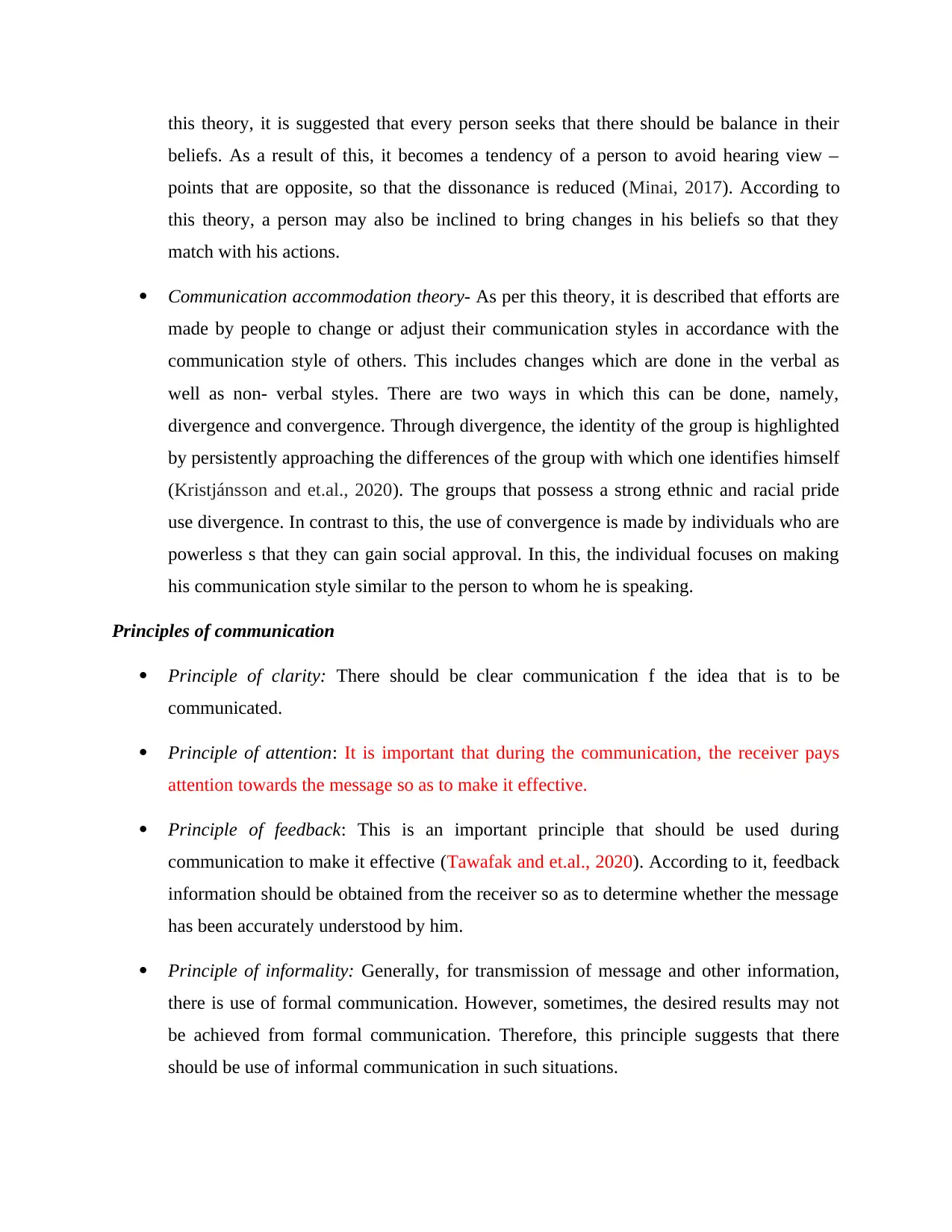
this theory, it is suggested that every person seeks that there should be balance in their
beliefs. As a result of this, it becomes a tendency of a person to avoid hearing view –
points that are opposite, so that the dissonance is reduced (Minai, 2017). According to
this theory, a person may also be inclined to bring changes in his beliefs so that they
match with his actions.
Communication accommodation theory- As per this theory, it is described that efforts are
made by people to change or adjust their communication styles in accordance with the
communication style of others. This includes changes which are done in the verbal as
well as non- verbal styles. There are two ways in which this can be done, namely,
divergence and convergence. Through divergence, the identity of the group is highlighted
by persistently approaching the differences of the group with which one identifies himself
(Kristjánsson and et.al., 2020). The groups that possess a strong ethnic and racial pride
use divergence. In contrast to this, the use of convergence is made by individuals who are
powerless s that they can gain social approval. In this, the individual focuses on making
his communication style similar to the person to whom he is speaking.
Principles of communication
Principle of clarity: There should be clear communication f the idea that is to be
communicated.
Principle of attention: It is important that during the communication, the receiver pays
attention towards the message so as to make it effective.
Principle of feedback: This is an important principle that should be used during
communication to make it effective (Tawafak and et.al., 2020). According to it, feedback
information should be obtained from the receiver so as to determine whether the message
has been accurately understood by him.
Principle of informality: Generally, for transmission of message and other information,
there is use of formal communication. However, sometimes, the desired results may not
be achieved from formal communication. Therefore, this principle suggests that there
should be use of informal communication in such situations.
beliefs. As a result of this, it becomes a tendency of a person to avoid hearing view –
points that are opposite, so that the dissonance is reduced (Minai, 2017). According to
this theory, a person may also be inclined to bring changes in his beliefs so that they
match with his actions.
Communication accommodation theory- As per this theory, it is described that efforts are
made by people to change or adjust their communication styles in accordance with the
communication style of others. This includes changes which are done in the verbal as
well as non- verbal styles. There are two ways in which this can be done, namely,
divergence and convergence. Through divergence, the identity of the group is highlighted
by persistently approaching the differences of the group with which one identifies himself
(Kristjánsson and et.al., 2020). The groups that possess a strong ethnic and racial pride
use divergence. In contrast to this, the use of convergence is made by individuals who are
powerless s that they can gain social approval. In this, the individual focuses on making
his communication style similar to the person to whom he is speaking.
Principles of communication
Principle of clarity: There should be clear communication f the idea that is to be
communicated.
Principle of attention: It is important that during the communication, the receiver pays
attention towards the message so as to make it effective.
Principle of feedback: This is an important principle that should be used during
communication to make it effective (Tawafak and et.al., 2020). According to it, feedback
information should be obtained from the receiver so as to determine whether the message
has been accurately understood by him.
Principle of informality: Generally, for transmission of message and other information,
there is use of formal communication. However, sometimes, the desired results may not
be achieved from formal communication. Therefore, this principle suggests that there
should be use of informal communication in such situations.
Paraphrase This Document
Need a fresh take? Get an instant paraphrase of this document with our AI Paraphraser
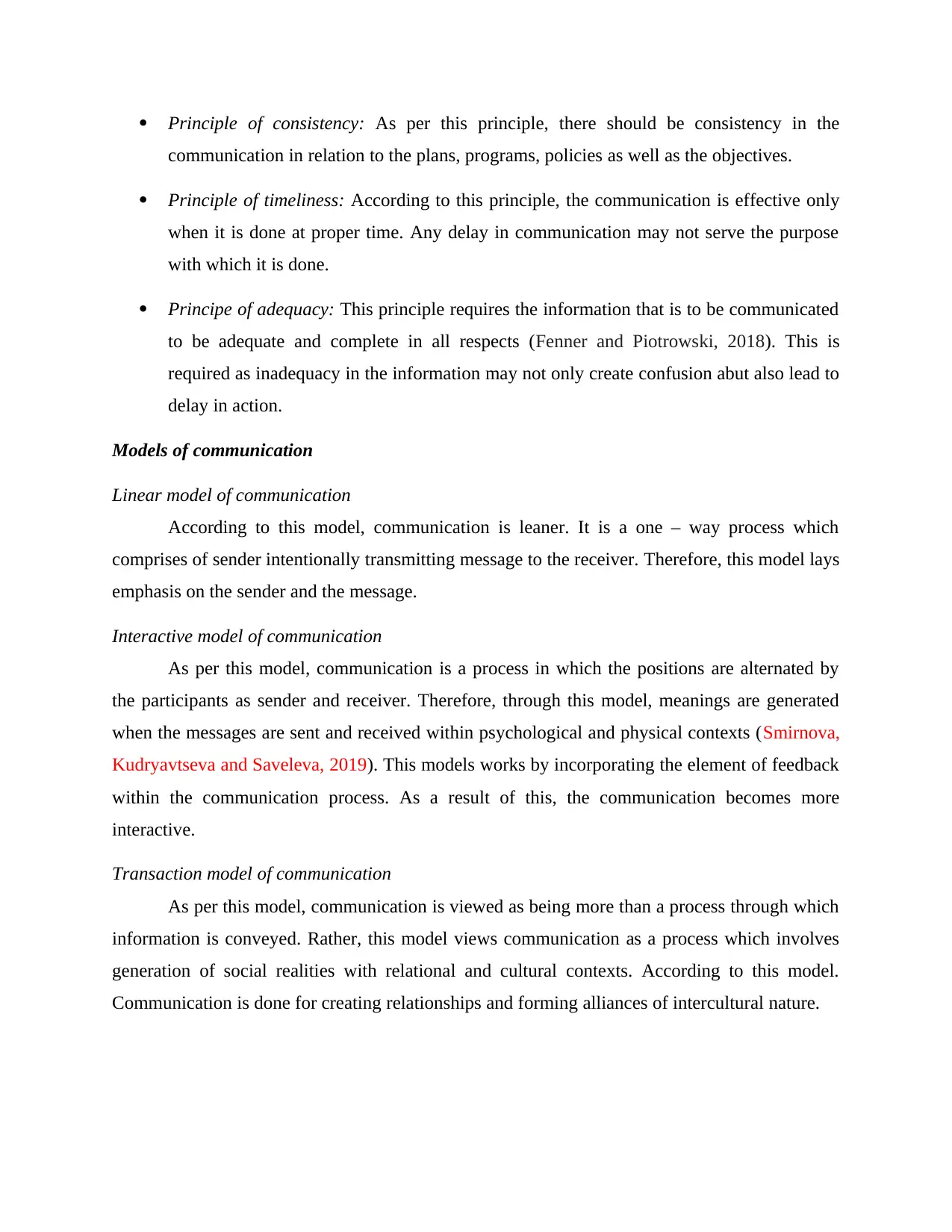
Principle of consistency: As per this principle, there should be consistency in the
communication in relation to the plans, programs, policies as well as the objectives.
Principle of timeliness: According to this principle, the communication is effective only
when it is done at proper time. Any delay in communication may not serve the purpose
with which it is done.
Principe of adequacy: This principle requires the information that is to be communicated
to be adequate and complete in all respects (Fenner and Piotrowski, 2018). This is
required as inadequacy in the information may not only create confusion abut also lead to
delay in action.
Models of communication
Linear model of communication
According to this model, communication is leaner. It is a one – way process which
comprises of sender intentionally transmitting message to the receiver. Therefore, this model lays
emphasis on the sender and the message.
Interactive model of communication
As per this model, communication is a process in which the positions are alternated by
the participants as sender and receiver. Therefore, through this model, meanings are generated
when the messages are sent and received within psychological and physical contexts (Smirnova,
Kudryavtseva and Saveleva, 2019). This models works by incorporating the element of feedback
within the communication process. As a result of this, the communication becomes more
interactive.
Transaction model of communication
As per this model, communication is viewed as being more than a process through which
information is conveyed. Rather, this model views communication as a process which involves
generation of social realities with relational and cultural contexts. According to this model.
Communication is done for creating relationships and forming alliances of intercultural nature.
communication in relation to the plans, programs, policies as well as the objectives.
Principle of timeliness: According to this principle, the communication is effective only
when it is done at proper time. Any delay in communication may not serve the purpose
with which it is done.
Principe of adequacy: This principle requires the information that is to be communicated
to be adequate and complete in all respects (Fenner and Piotrowski, 2018). This is
required as inadequacy in the information may not only create confusion abut also lead to
delay in action.
Models of communication
Linear model of communication
According to this model, communication is leaner. It is a one – way process which
comprises of sender intentionally transmitting message to the receiver. Therefore, this model lays
emphasis on the sender and the message.
Interactive model of communication
As per this model, communication is a process in which the positions are alternated by
the participants as sender and receiver. Therefore, through this model, meanings are generated
when the messages are sent and received within psychological and physical contexts (Smirnova,
Kudryavtseva and Saveleva, 2019). This models works by incorporating the element of feedback
within the communication process. As a result of this, the communication becomes more
interactive.
Transaction model of communication
As per this model, communication is viewed as being more than a process through which
information is conveyed. Rather, this model views communication as a process which involves
generation of social realities with relational and cultural contexts. According to this model.
Communication is done for creating relationships and forming alliances of intercultural nature.
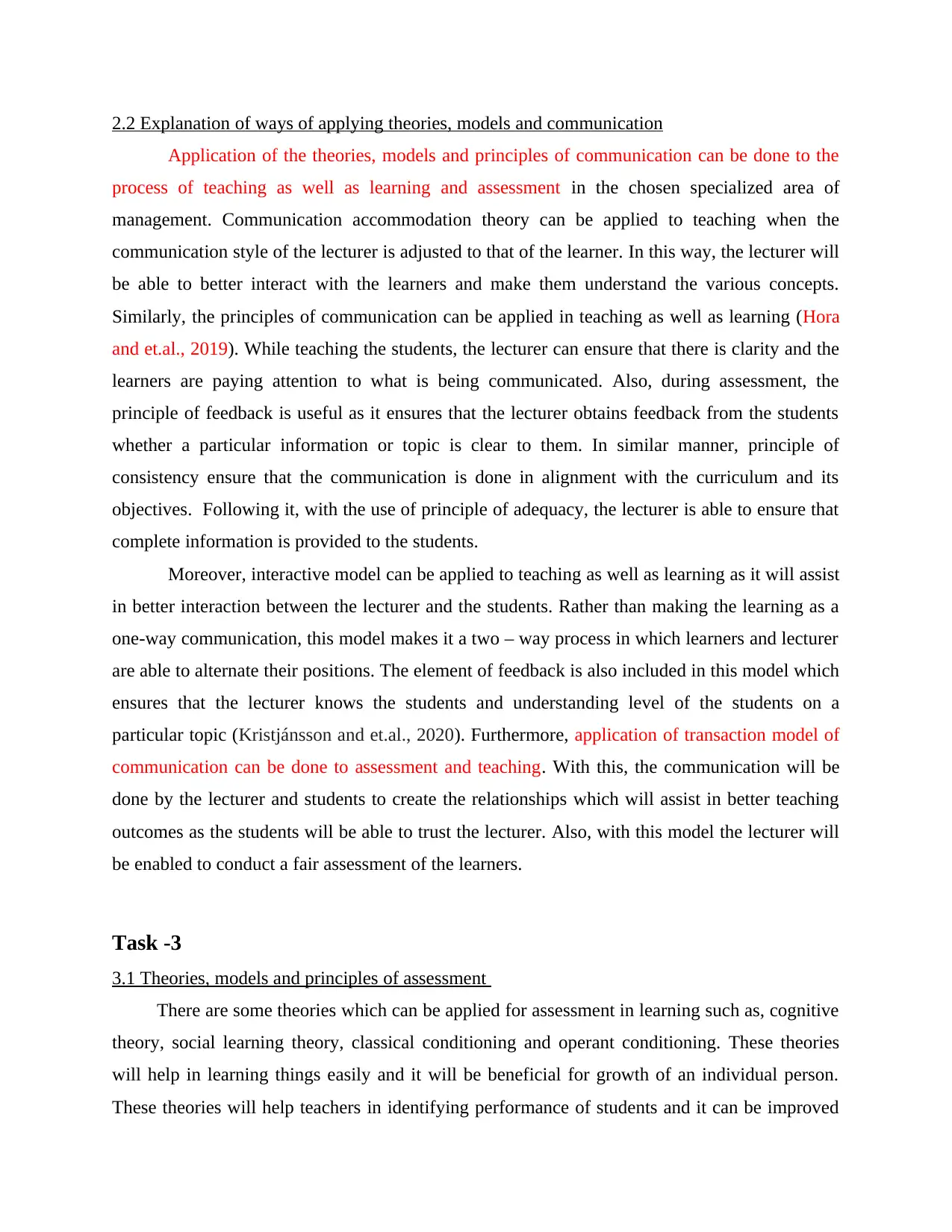
2.2 Explanation of ways of applying theories, models and communication
Application of the theories, models and principles of communication can be done to the
process of teaching as well as learning and assessment in the chosen specialized area of
management. Communication accommodation theory can be applied to teaching when the
communication style of the lecturer is adjusted to that of the learner. In this way, the lecturer will
be able to better interact with the learners and make them understand the various concepts.
Similarly, the principles of communication can be applied in teaching as well as learning (Hora
and et.al., 2019). While teaching the students, the lecturer can ensure that there is clarity and the
learners are paying attention to what is being communicated. Also, during assessment, the
principle of feedback is useful as it ensures that the lecturer obtains feedback from the students
whether a particular information or topic is clear to them. In similar manner, principle of
consistency ensure that the communication is done in alignment with the curriculum and its
objectives. Following it, with the use of principle of adequacy, the lecturer is able to ensure that
complete information is provided to the students.
Moreover, interactive model can be applied to teaching as well as learning as it will assist
in better interaction between the lecturer and the students. Rather than making the learning as a
one-way communication, this model makes it a two – way process in which learners and lecturer
are able to alternate their positions. The element of feedback is also included in this model which
ensures that the lecturer knows the students and understanding level of the students on a
particular topic (Kristjánsson and et.al., 2020). Furthermore, application of transaction model of
communication can be done to assessment and teaching. With this, the communication will be
done by the lecturer and students to create the relationships which will assist in better teaching
outcomes as the students will be able to trust the lecturer. Also, with this model the lecturer will
be enabled to conduct a fair assessment of the learners.
Task -3
3.1 Theories, models and principles of assessment
There are some theories which can be applied for assessment in learning such as, cognitive
theory, social learning theory, classical conditioning and operant conditioning. These theories
will help in learning things easily and it will be beneficial for growth of an individual person.
These theories will help teachers in identifying performance of students and it can be improved
Application of the theories, models and principles of communication can be done to the
process of teaching as well as learning and assessment in the chosen specialized area of
management. Communication accommodation theory can be applied to teaching when the
communication style of the lecturer is adjusted to that of the learner. In this way, the lecturer will
be able to better interact with the learners and make them understand the various concepts.
Similarly, the principles of communication can be applied in teaching as well as learning (Hora
and et.al., 2019). While teaching the students, the lecturer can ensure that there is clarity and the
learners are paying attention to what is being communicated. Also, during assessment, the
principle of feedback is useful as it ensures that the lecturer obtains feedback from the students
whether a particular information or topic is clear to them. In similar manner, principle of
consistency ensure that the communication is done in alignment with the curriculum and its
objectives. Following it, with the use of principle of adequacy, the lecturer is able to ensure that
complete information is provided to the students.
Moreover, interactive model can be applied to teaching as well as learning as it will assist
in better interaction between the lecturer and the students. Rather than making the learning as a
one-way communication, this model makes it a two – way process in which learners and lecturer
are able to alternate their positions. The element of feedback is also included in this model which
ensures that the lecturer knows the students and understanding level of the students on a
particular topic (Kristjánsson and et.al., 2020). Furthermore, application of transaction model of
communication can be done to assessment and teaching. With this, the communication will be
done by the lecturer and students to create the relationships which will assist in better teaching
outcomes as the students will be able to trust the lecturer. Also, with this model the lecturer will
be enabled to conduct a fair assessment of the learners.
Task -3
3.1 Theories, models and principles of assessment
There are some theories which can be applied for assessment in learning such as, cognitive
theory, social learning theory, classical conditioning and operant conditioning. These theories
will help in learning things easily and it will be beneficial for growth of an individual person.
These theories will help teachers in identifying performance of students and it can be improved
⊘ This is a preview!⊘
Do you want full access?
Subscribe today to unlock all pages.

Trusted by 1+ million students worldwide
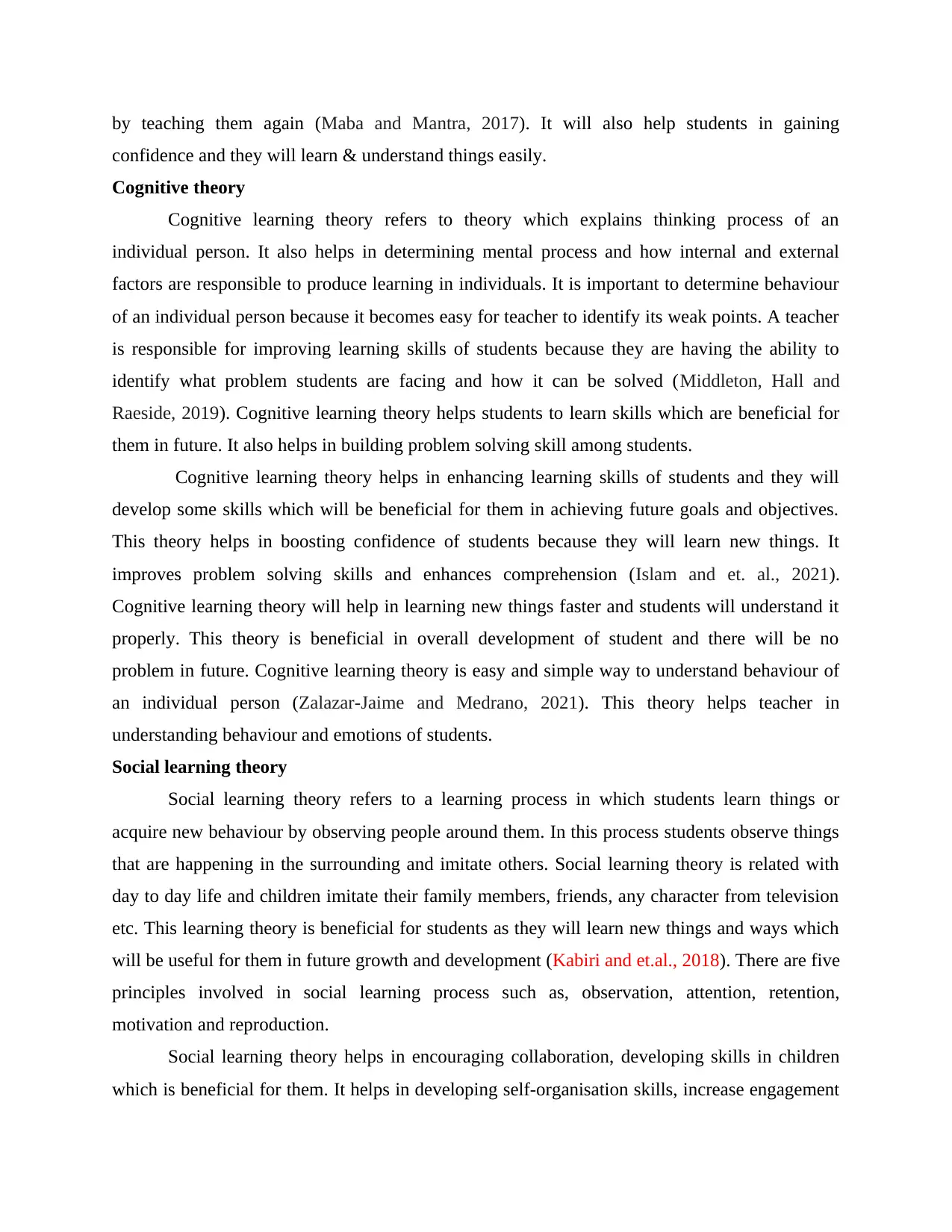
by teaching them again (Maba and Mantra, 2017). It will also help students in gaining
confidence and they will learn & understand things easily.
Cognitive theory
Cognitive learning theory refers to theory which explains thinking process of an
individual person. It also helps in determining mental process and how internal and external
factors are responsible to produce learning in individuals. It is important to determine behaviour
of an individual person because it becomes easy for teacher to identify its weak points. A teacher
is responsible for improving learning skills of students because they are having the ability to
identify what problem students are facing and how it can be solved (Middleton, Hall and
Raeside, 2019). Cognitive learning theory helps students to learn skills which are beneficial for
them in future. It also helps in building problem solving skill among students.
Cognitive learning theory helps in enhancing learning skills of students and they will
develop some skills which will be beneficial for them in achieving future goals and objectives.
This theory helps in boosting confidence of students because they will learn new things. It
improves problem solving skills and enhances comprehension (Islam and et. al., 2021).
Cognitive learning theory will help in learning new things faster and students will understand it
properly. This theory is beneficial in overall development of student and there will be no
problem in future. Cognitive learning theory is easy and simple way to understand behaviour of
an individual person (Zalazar-Jaime and Medrano, 2021). This theory helps teacher in
understanding behaviour and emotions of students.
Social learning theory
Social learning theory refers to a learning process in which students learn things or
acquire new behaviour by observing people around them. In this process students observe things
that are happening in the surrounding and imitate others. Social learning theory is related with
day to day life and children imitate their family members, friends, any character from television
etc. This learning theory is beneficial for students as they will learn new things and ways which
will be useful for them in future growth and development (Kabiri and et.al., 2018). There are five
principles involved in social learning process such as, observation, attention, retention,
motivation and reproduction.
Social learning theory helps in encouraging collaboration, developing skills in children
which is beneficial for them. It helps in developing self-organisation skills, increase engagement
confidence and they will learn & understand things easily.
Cognitive theory
Cognitive learning theory refers to theory which explains thinking process of an
individual person. It also helps in determining mental process and how internal and external
factors are responsible to produce learning in individuals. It is important to determine behaviour
of an individual person because it becomes easy for teacher to identify its weak points. A teacher
is responsible for improving learning skills of students because they are having the ability to
identify what problem students are facing and how it can be solved (Middleton, Hall and
Raeside, 2019). Cognitive learning theory helps students to learn skills which are beneficial for
them in future. It also helps in building problem solving skill among students.
Cognitive learning theory helps in enhancing learning skills of students and they will
develop some skills which will be beneficial for them in achieving future goals and objectives.
This theory helps in boosting confidence of students because they will learn new things. It
improves problem solving skills and enhances comprehension (Islam and et. al., 2021).
Cognitive learning theory will help in learning new things faster and students will understand it
properly. This theory is beneficial in overall development of student and there will be no
problem in future. Cognitive learning theory is easy and simple way to understand behaviour of
an individual person (Zalazar-Jaime and Medrano, 2021). This theory helps teacher in
understanding behaviour and emotions of students.
Social learning theory
Social learning theory refers to a learning process in which students learn things or
acquire new behaviour by observing people around them. In this process students observe things
that are happening in the surrounding and imitate others. Social learning theory is related with
day to day life and children imitate their family members, friends, any character from television
etc. This learning theory is beneficial for students as they will learn new things and ways which
will be useful for them in future growth and development (Kabiri and et.al., 2018). There are five
principles involved in social learning process such as, observation, attention, retention,
motivation and reproduction.
Social learning theory helps in encouraging collaboration, developing skills in children
which is beneficial for them. It helps in developing self-organisation skills, increase engagement
Paraphrase This Document
Need a fresh take? Get an instant paraphrase of this document with our AI Paraphraser
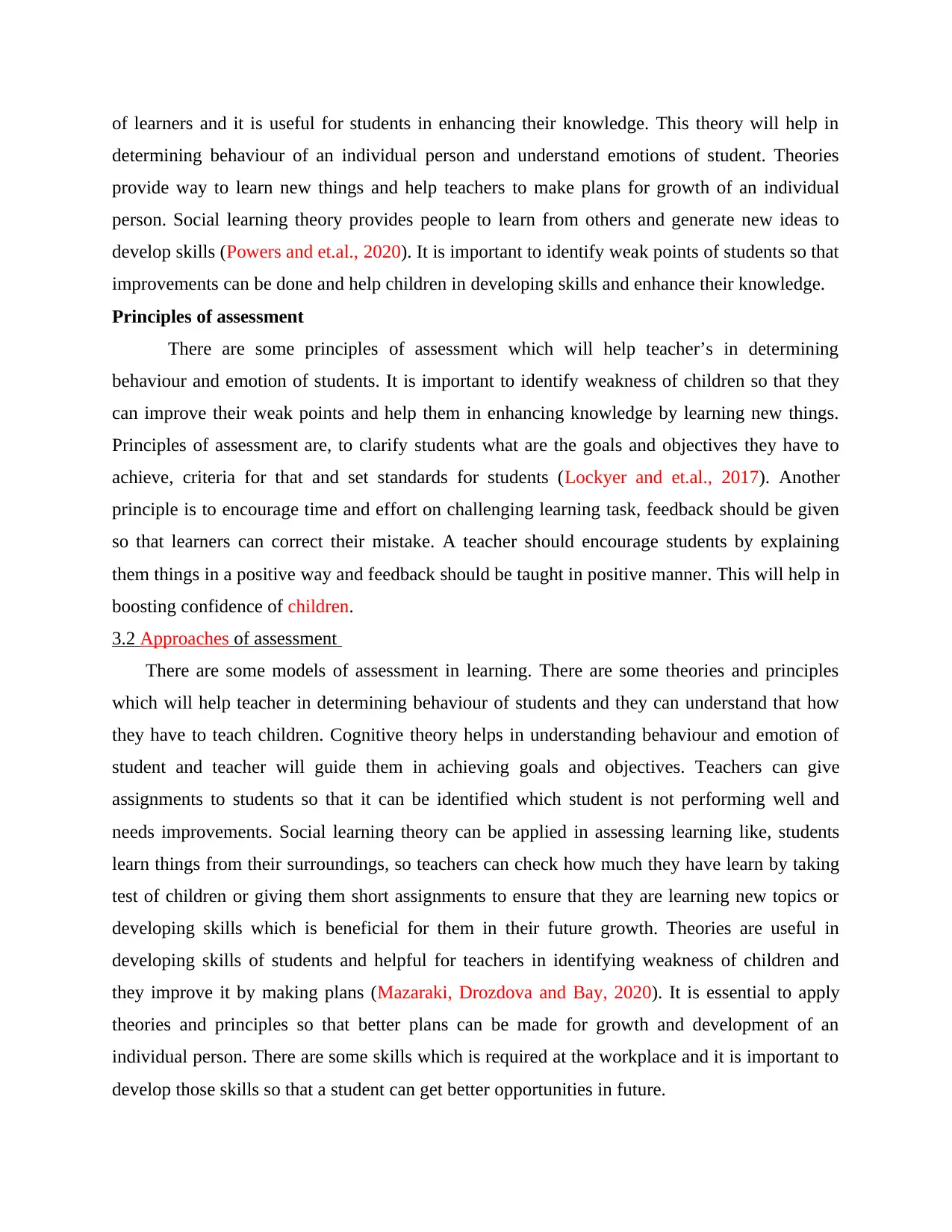
of learners and it is useful for students in enhancing their knowledge. This theory will help in
determining behaviour of an individual person and understand emotions of student. Theories
provide way to learn new things and help teachers to make plans for growth of an individual
person. Social learning theory provides people to learn from others and generate new ideas to
develop skills (Powers and et.al., 2020). It is important to identify weak points of students so that
improvements can be done and help children in developing skills and enhance their knowledge.
Principles of assessment
There are some principles of assessment which will help teacher’s in determining
behaviour and emotion of students. It is important to identify weakness of children so that they
can improve their weak points and help them in enhancing knowledge by learning new things.
Principles of assessment are, to clarify students what are the goals and objectives they have to
achieve, criteria for that and set standards for students (Lockyer and et.al., 2017). Another
principle is to encourage time and effort on challenging learning task, feedback should be given
so that learners can correct their mistake. A teacher should encourage students by explaining
them things in a positive way and feedback should be taught in positive manner. This will help in
boosting confidence of children.
3.2 Approaches of assessment
There are some models of assessment in learning. There are some theories and principles
which will help teacher in determining behaviour of students and they can understand that how
they have to teach children. Cognitive theory helps in understanding behaviour and emotion of
student and teacher will guide them in achieving goals and objectives. Teachers can give
assignments to students so that it can be identified which student is not performing well and
needs improvements. Social learning theory can be applied in assessing learning like, students
learn things from their surroundings, so teachers can check how much they have learn by taking
test of children or giving them short assignments to ensure that they are learning new topics or
developing skills which is beneficial for them in their future growth. Theories are useful in
developing skills of students and helpful for teachers in identifying weakness of children and
they improve it by making plans (Mazaraki, Drozdova and Bay, 2020). It is essential to apply
theories and principles so that better plans can be made for growth and development of an
individual person. There are some skills which is required at the workplace and it is important to
develop those skills so that a student can get better opportunities in future.
determining behaviour of an individual person and understand emotions of student. Theories
provide way to learn new things and help teachers to make plans for growth of an individual
person. Social learning theory provides people to learn from others and generate new ideas to
develop skills (Powers and et.al., 2020). It is important to identify weak points of students so that
improvements can be done and help children in developing skills and enhance their knowledge.
Principles of assessment
There are some principles of assessment which will help teacher’s in determining
behaviour and emotion of students. It is important to identify weakness of children so that they
can improve their weak points and help them in enhancing knowledge by learning new things.
Principles of assessment are, to clarify students what are the goals and objectives they have to
achieve, criteria for that and set standards for students (Lockyer and et.al., 2017). Another
principle is to encourage time and effort on challenging learning task, feedback should be given
so that learners can correct their mistake. A teacher should encourage students by explaining
them things in a positive way and feedback should be taught in positive manner. This will help in
boosting confidence of children.
3.2 Approaches of assessment
There are some models of assessment in learning. There are some theories and principles
which will help teacher in determining behaviour of students and they can understand that how
they have to teach children. Cognitive theory helps in understanding behaviour and emotion of
student and teacher will guide them in achieving goals and objectives. Teachers can give
assignments to students so that it can be identified which student is not performing well and
needs improvements. Social learning theory can be applied in assessing learning like, students
learn things from their surroundings, so teachers can check how much they have learn by taking
test of children or giving them short assignments to ensure that they are learning new topics or
developing skills which is beneficial for them in their future growth. Theories are useful in
developing skills of students and helpful for teachers in identifying weakness of children and
they improve it by making plans (Mazaraki, Drozdova and Bay, 2020). It is essential to apply
theories and principles so that better plans can be made for growth and development of an
individual person. There are some skills which is required at the workplace and it is important to
develop those skills so that a student can get better opportunities in future.
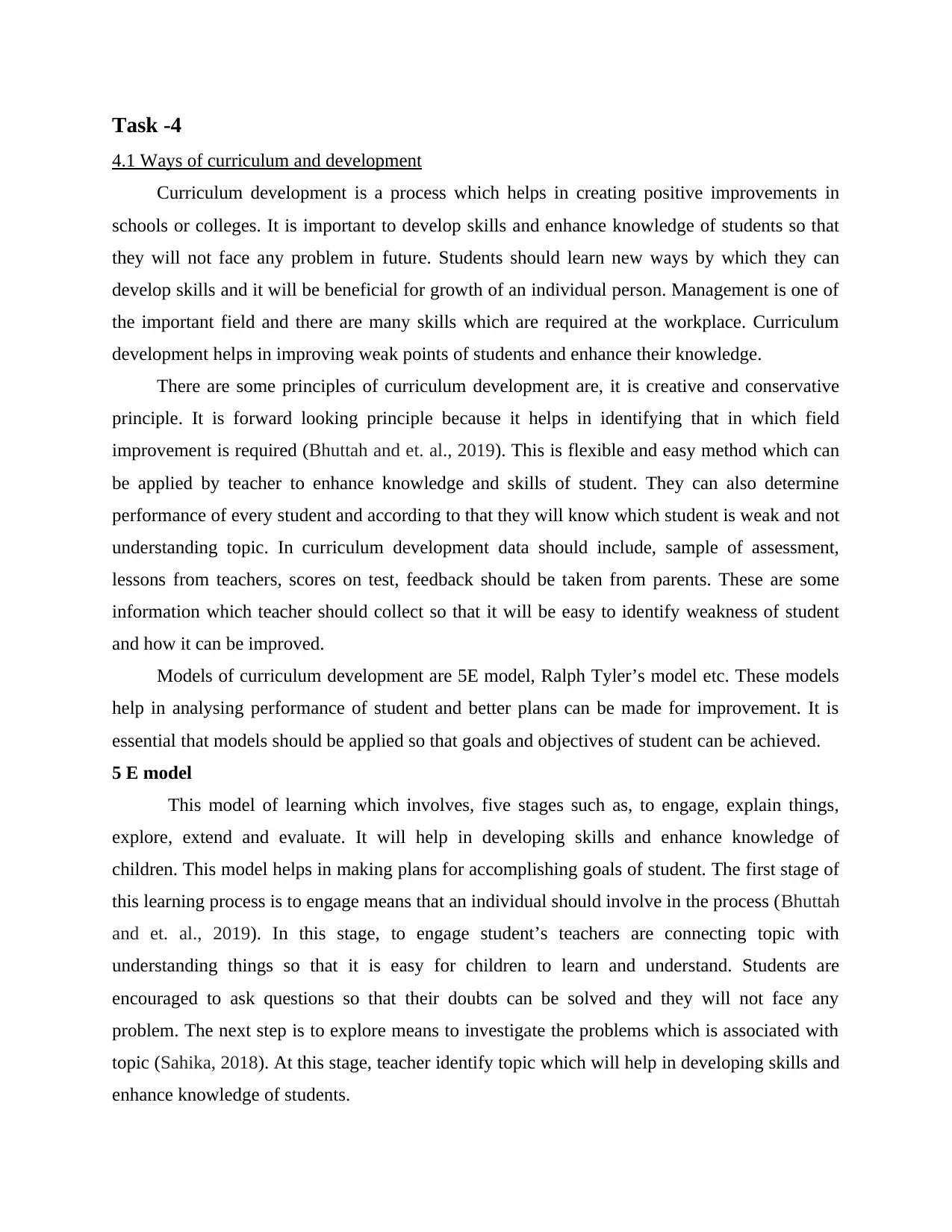
Task -4
4.1 Ways of curriculum and development
Curriculum development is a process which helps in creating positive improvements in
schools or colleges. It is important to develop skills and enhance knowledge of students so that
they will not face any problem in future. Students should learn new ways by which they can
develop skills and it will be beneficial for growth of an individual person. Management is one of
the important field and there are many skills which are required at the workplace. Curriculum
development helps in improving weak points of students and enhance their knowledge.
There are some principles of curriculum development are, it is creative and conservative
principle. It is forward looking principle because it helps in identifying that in which field
improvement is required (Bhuttah and et. al., 2019). This is flexible and easy method which can
be applied by teacher to enhance knowledge and skills of student. They can also determine
performance of every student and according to that they will know which student is weak and not
understanding topic. In curriculum development data should include, sample of assessment,
lessons from teachers, scores on test, feedback should be taken from parents. These are some
information which teacher should collect so that it will be easy to identify weakness of student
and how it can be improved.
Models of curriculum development are 5E model, Ralph Tyler’s model etc. These models
help in analysing performance of student and better plans can be made for improvement. It is
essential that models should be applied so that goals and objectives of student can be achieved.
5 E model
This model of learning which involves, five stages such as, to engage, explain things,
explore, extend and evaluate. It will help in developing skills and enhance knowledge of
children. This model helps in making plans for accomplishing goals of student. The first stage of
this learning process is to engage means that an individual should involve in the process (Bhuttah
and et. al., 2019). In this stage, to engage student’s teachers are connecting topic with
understanding things so that it is easy for children to learn and understand. Students are
encouraged to ask questions so that their doubts can be solved and they will not face any
problem. The next step is to explore means to investigate the problems which is associated with
topic (Sahika, 2018). At this stage, teacher identify topic which will help in developing skills and
enhance knowledge of students.
4.1 Ways of curriculum and development
Curriculum development is a process which helps in creating positive improvements in
schools or colleges. It is important to develop skills and enhance knowledge of students so that
they will not face any problem in future. Students should learn new ways by which they can
develop skills and it will be beneficial for growth of an individual person. Management is one of
the important field and there are many skills which are required at the workplace. Curriculum
development helps in improving weak points of students and enhance their knowledge.
There are some principles of curriculum development are, it is creative and conservative
principle. It is forward looking principle because it helps in identifying that in which field
improvement is required (Bhuttah and et. al., 2019). This is flexible and easy method which can
be applied by teacher to enhance knowledge and skills of student. They can also determine
performance of every student and according to that they will know which student is weak and not
understanding topic. In curriculum development data should include, sample of assessment,
lessons from teachers, scores on test, feedback should be taken from parents. These are some
information which teacher should collect so that it will be easy to identify weakness of student
and how it can be improved.
Models of curriculum development are 5E model, Ralph Tyler’s model etc. These models
help in analysing performance of student and better plans can be made for improvement. It is
essential that models should be applied so that goals and objectives of student can be achieved.
5 E model
This model of learning which involves, five stages such as, to engage, explain things,
explore, extend and evaluate. It will help in developing skills and enhance knowledge of
children. This model helps in making plans for accomplishing goals of student. The first stage of
this learning process is to engage means that an individual should involve in the process (Bhuttah
and et. al., 2019). In this stage, to engage student’s teachers are connecting topic with
understanding things so that it is easy for children to learn and understand. Students are
encouraged to ask questions so that their doubts can be solved and they will not face any
problem. The next step is to explore means to investigate the problems which is associated with
topic (Sahika, 2018). At this stage, teacher identify topic which will help in developing skills and
enhance knowledge of students.
⊘ This is a preview!⊘
Do you want full access?
Subscribe today to unlock all pages.

Trusted by 1+ million students worldwide
1 out of 17
Related Documents
Your All-in-One AI-Powered Toolkit for Academic Success.
+13062052269
info@desklib.com
Available 24*7 on WhatsApp / Email
![[object Object]](/_next/static/media/star-bottom.7253800d.svg)
Unlock your academic potential
Copyright © 2020–2025 A2Z Services. All Rights Reserved. Developed and managed by ZUCOL.




